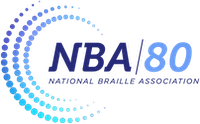Search Results for 'cartesian'
-
Search Results
-
Topic: Labels on Tactile Graphics
I have a question about a Transcribers generated label on a graphic. If you have a large cartesian grid that is necessary to split in 4 sections, can you use the label Quad 1, Quad 2, Quad 3, Quad 4, enclosed in Transcribers note indicators for identification of the sections?
Thanks!
Greetings to you TG experts!
In addition to our question about rulers, we have a question about numeric indicators and measuring tools.
Our reading of print pages 6–2 and 6–3 of the Guidelines and Standards for Tactile Graphics, 2022 leads us to the conclusion that the numeric indicator SHOULD be included on graduated cylinders, beakers, measuring cups, and other liquid measuring tools (that is, for graphics of measuring tools other than those specified in the chart on page 6-3). Is our conclusion correct?
Specifically, GSTG says, “In general, regardless of the braille code used, the numeric indicator should be omitted when depicting measuring tools, number lines, and multiple-quadrant Cartesian graphs.” then the chart on page 6–3 lists specific measuring tools: barometers, clocks, protractors, rulers, and thermometers. Below the chart it reads, “Use the numeric indicator for graphics that are not specified in the chart above.” So, should the numeric indicator be included on graduated cylinders, beakers, measuring cups, or other liquid measuring tools?
Thank you,
–Kyle DeJute and some APH colleaguesI have a couple of formatting questions about dealing with Nemeth indicators and Cartesian graphs:
In the new <u>Guidelines and Standards for Tactile Graphics, 2022</u> under §6.6.2 it states, “The opening Nemeth Code indicator and Nemeth Code terminator are not used before and after multiple-quadrant Cartesian graphs transcribed in Nemeth.” This is understood (see Exercises 5 and 12 on the attached .pdf), but what happens when the graph is preceded or followed by Nemeth text? (See Exercises 4 and 9) For Exercise 4 do I insert the opening Nemeth indicator before the graph at the end of the exercise text and place the terminator at the end of subentry D.? Or, does the opening Nemeth indicator need to be inserted before subentry A? In Exercise 9 I assume that Nemeth continues through the graph with no additional indicators like it was done in the past.
What is done when there is only an exercise identifier and a Cartesian graph on the braille page with no immediately preceding or following Nemeth material? I feel the identifier remains in UEB.
When within a Nemeth transcription is there a rule dictating that all analog clocks and graphs (other than cartesian) to be in Nemeth?
Or is it preferred to be transcribed in UEB when no Nemeth symbols are used? We were unable to find anything specific to this.Thank you for your time.
This is a UEB with Nemeth transcription. Please see the attached print example.
When a sentence ends with math, then a Cartesian graph follows, then a table requiring Nemeth (or any kind of math for that matter) follows the graph, where do I open and close Nemeth? I explain on the Transcriber's Notes page that Nemeth code switch indicators are omitted for Cartesian graphs. In this case then, do I close Nemeth just prior to the period in the sentence before the graph or do I use a punctuation indicator before the period and keep Nemeth going? Also, since the Transcriber's note implies that Nemeth ends after the graph, should I use the Nemeth opening box line for the table (or opening switch indicator for any math) that follows the Cartesian graph?
~Laurie
Hi,
I am a newbie and would like to confirm my understanding from the Tactile Graphic Guidelines" that while creating tactile Cartesian graphs, the grids should be assigned the least weight and the plotted curve/line/shape should have the most. Is that correct?
Also, I see that while creating digital diagrams that can be embossed, colors can be used to make the grid lines the least distinct, even f the same weight is used for both the grid lines and plotted curves/lines itself to distinguish the two. But, I have noticed that this doesn't work while using Swell paper. In that case is it ok to distinguish the grid lines from the plotted line/curve/figure by assigning different weights or is there a specific weight that need to be used for swell paper?
Appreciate any guidance that can be provided!!
